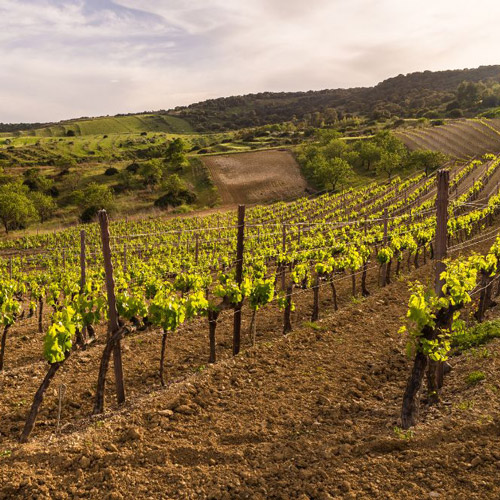-
Canopy Management
- » DF Pneumatic Leaf Remover
- » C-305 Independent Hydraulic Power Unit
- » CM-FF – Orchard Topper
- » CM-SF – Synchronized Bar Mower Topper
- » CM-SD – Synchronized Double Topping Machine
- » CM-SDT – Simple Synchronized Double Topping Machine
- » CM-SNU – Over-the-Row Topping Machine
- » CM-SNE – Electric and Hybrid Synchronized Topping Machine
- » CM-B – Basic Topping Machine
- » CM-SN New Model Synchronized Topping Machine
- » CM-S Synchronized Topping Machine
The vineyards and clay soil: agronomic techniques to promote efficient drainage

The viticulture, which has its roots in the practices thousands of years old, is now interpreted as an advanced science. At the heart of this discipline there is the soil, the fundamental element which not only supports the physical lives, but has a profound impact on every aspect of its growth, from the root development to the production of quality wine grapes. While each vineyard is a mosaic of variables, including climate, grape varieties and agronomic practices, the soil on which they are grown, remains one of the major influences on the quality and quantity of wine produced. In particular, the clay soils, with their distinctive characteristics, present challenges and opportunities unique to the winemaker. This article aims to explore in depth the dynamics of the clay soils in the vineyards, facing their properties, challenges, and techniques in agricultural practices for their management.
Characteristics of Clay Soil
In the vast landscape of the agricultural soils, the clay soils occupy an important position for their specificity. These soils are characterized by a fine texture, due to the predominant presence of mineral particles of extremely small size. This particular texture is the result of the concentration of particles of clay, which give the soil a number of unique properties.
One of the most distinctive of clayey soils is their high capacity of water retention. This means that they are able to retain thethe water much more effectively than other types of soil, such as sandy ones. Although this may seem to be an advantage, in reality, it presents challenges. Lretained water in excess in the pores of the soil can lead to saturation conditions, creating the potential problems of stagnation and asphyxia radical.
In addition to water retention, clay soils are known for their fertility. Thanks to their high cation exchange capacity, these soils are often rich in cations and other essential nutrients. This nutritional richness, however, if not managed properly, can lead to imbalances and deficiencies.
Water management and the Challenges of Clayey Soils
Lwater is essential for plant life, but, as often happens, the excess can be problematic. The water management in the clayey soils is one of the main challenges for the wine-grower. The ability of these soils to retain thewater, if on the one hand can serve as a resource in times of drought, fromthe other it can lead to problems related to stagnation dwater. These wetlands can cause asphyxiation radical, a condition in which the roots of the plants are free delloxygen necessary for their vital functions, such asnutrient absorption, and respiration.
In parallel, a clay soil constantly moist, it can become a fertile ground for theemergence of pathogens. These pathogenic organisms, such as fungi and bacteria, are in a humid environment, the ideal conditions for the proliferation and can attack both roots and the aerial parts of the plants. In particular, the stagnation dwater can favor the appearance of fungal diseases, which can severely damage plants and reduce the productivity of the vineyard.
The challenges presented by the management of water in clay soils require theadoption of agricultural techniques specific to ensure that thewater in the soil is balanced and does not lead to adverse conditions for the screws.
Pathogens and Clayey Soils
is A crucial aspect in the management of clay soils in the context of the wine is the understanding of the interactions between the soil, thewater and the biota. The clayey soils, due to their tendency to assume lwater, they can easily become theperfect habitat for different pathogens. These pathogens, including various fungi, bacteria and nematodes, may have direct and indirect impact on the health of the vines.
In the conditions of stagnation and prolonged, the ground can become anaerobic, offering the optimal conditions for the proliferation of pathogenic organisms are anaerobic. These organisms can cause a variety of diseases to the roots, ranging from the simple reduction of growth to structural damage, serious. The damaged roots not only reduce the ability of the plant to absorb nutrients and water, but they can also become input ports for other pathogens.
In addition to soil pathogens, lexcessive humidity favors the appearance of fungal diseases on the aerial parts of the plant. These diseases, such as downy mildew or lpowdery mildew, can dramatically reduce the productivity of the vineyard and the quality of thegrapes.
The understanding of the dynamics of pathogens in the clayey soils and theadoption of preventive strategies, and healing are essential to ensure the health of the vineyard and the quality of the wine produced.
The dynamics of Nutrition in the Clay Soils
One of the fundamental aspects of viticulture is to ensure a supply of balanced nutrients screws. The clayey soils, due to their structure and cation exchange capacity, are often rich in essential minerals. However, this does not necessarily mean that they are always perfectly balanced from a nutritional point of view.
The ability of a clay soil to holdwater can influence the mobility and the availability of certain nutrients. For example, stagnation conditions, elements such asnitrogen, essential for the growth of plants, may undergo the processes of denitrification, reducing its availability to plants.
In parallel, the rich endowment of cations of the clay soils can lead to the phenomena of antagonism between nutrients. This occurs when the presence of high nutrient prevents or reduces theabsorption of another. A classic example is theantagonism between calcium and magnesium, where an excess of one can inhibit theabsorptionof another.
The nutritional management in the clayey soils, therefore, requires a deep understanding of the dynamics of the soil and of the specific needs of the screws. Lthe objective is to ensure a balanced intake of nutrients by avoiding imbalances that can affect the growth of the plant and the quality ofthe grapes.
Agronomic techniques for Drainage
drainage effective, it is essential to manage the water challenges of the clay soils in the context of the wine. To maintain an optimal balance dellsoil moisture not only prevents lasphyxia radical and the proliferation of pathogens, but also promotes a uniform distribution of nutrients.
One of the common techniques adopted to improve drainage in clay soils is the deeper work. This agronomic practice, through theuse of specialist equipment, and breaks down the layers of compact soil, improving the percolation dellwater through the deeper layers.
Ladoption of drain trenches, or systems of underground drainage can be analternative solution is effective. These systems, correctly positioned, collect and transport lexcess water away from the roots of the plants, preventing stagnation, superficial and deep.
Finally, the choice of rootstocks suitable can play a crucial role. Some rootstocks are known for their ability to tolerate soil conditions, unless drained, offering a certain resistance toasphyxia radical.
LImpact of the Drainage on the Quality of the Wine
In the wine-growing, the quality of the wine produced is closely linked to the conditions in which the vines grow. Water management, and in particular the drainage, has a direct impact on many aspects of wine production.
First of all, a drain effectively prevents lasphyxia radical, ensuring the roots of a constant supply of oxygen. This, in turn, affects the ability of the plant to absorb nutrients and its resistance to various diseases. The roots healthy and well-nourished can positively influence the growth of the plant, the maturation of thegrapes and, therefore, the organoleptic characteristics of the wine produced.
In addition to direct effects on the plant, good drainage also affects soil microbiology. A well-drained soil supports a microbial community is diverse and balanced, which can contribute to the prevention of diseases and the improvement of the soil structure. These microorganisms play a key role in the transformation of nutrients, making them available for the plants, and can affect directly and indirectly the quality of the wine.
Climate change and theAdaptability of the Vineyards of Clayey soil
, The climate change it is one of the most pressing challenges of our time, and its effects permeate every sector, including viticulture. The vineyards, as they are extremely sensitive to climatic changes, are experimenting with alterations in the seasons of growth, in the dynamics of precipitation and average temperatures. These changes have a direct impact on the clay soils. An increase in rainfall, for example, can exacerbate the problems of stagnation dthe water in these soils, while prolonged periods of drought could intensify water stress, despite the inherent capacity of these soils to holdwater. In parallel, higher temperatures may affect the decomposition of organic matter in the soil, altering the dynamics of nutrition and microbiology of the soil. In the face of these challenges, agronomists, and growers need to adopt innovative and sustainable strategies, ensuring the protection ofecosystem of the vineyard and the production of high quality wines. Understanding clay soil, combined with a research-based approach and theinnovation will be crucial to successfully address the challenges presented by climate change.
Adapting the Viticultural and Innovations for a Sustainable Future
Inthe era of climate change, theadaptation andinnovation become imperative for viticulture. The effects of global warming are not uniform: while some regions may benefit from anextension of the growing season, the other can deal with extreme droughts, torrential rains, or the new threats of diseases. The vineyards located on clay soils, with their water retention capacity, can provide a certain degree of resilience against droughts, but at the same time, they can be vulnerable to stagnation dwater in periods of heavy rains.
Ladaptation in viticulture is not limited to the choice of varieties which are more resistant, orthe adoption of new irrigation techniques. Also applies to the understanding and management of the soil. Interventions such as tillage, theadoption of vegetation cover, or lintroduction of organic matter can improve the soil structure, increase its drainage capacity and strengthen its resilience to climate change.
At the same time, theinnovation plays a key role. Agricultural research institute, through advanced studies and experiments, is bringing to light new methodologies and practices to address the climatic challenges and emerging markets. Ladoption of advanced technologies, such as the monitoring systems of the soil or real-time applications based on artificial intelligence for the prediction and management of water resources, can provide farmers with valuable tools for a sustainable and resilient of the vineyard. In this ever-changing panorama, the combination of tradition, scientific knowledge and technological innovation will be crucial to ensure a prosperous future for the wine-growing in clay soils.

